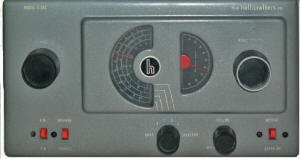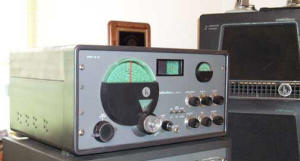Old Time Radio
Reliving Our Parents Memories Seventy Years Later
Shortwave Listening
 Shortwave radio operates between the frequencies of 3 MHz (3,000 kHz) and 30 MHz (30,000 kHz) and came to be referred to as such in the early days of radio because the wavelengths associated with this frequency range were shorter than the long wave lengths widely in use at that time. I spent hours chasing "
DX
".
Shortwave radio operates between the frequencies of 3 MHz (3,000 kHz) and 30 MHz (30,000 kHz) and came to be referred to as such in the early days of radio because the wavelengths associated with this frequency range were shorter than the long wave lengths widely in use at that time. I spent hours chasing "
DX
".
An alternate name is HF or high frequency radio. Short wavelengths are associated with high frequencies because there is an inverse relationship between frequency and wavelength.
Short Wave Bands
At WRC-97 in 1997, the following bands were allocated for
international broadcasting
. (listed in the table). As a teenager, I would spend hours and hours straining my ears to extract some small countries shortwave broadcasts from the ether.
| Meter Band | Frequency Range |
|---|---|
| 120 m | 2,300 - 2,495 kHz |
| 90 m | 3,200 - 3,400 kHz |
| 75 m | 3,900 - 4,000 kHz |
| 60 m | 4,750 - 5,060 kHz |
| 49 m | 5,900 - 6,200 kHz |
| 40 m/41m | 7,100 - 7,350 kHz |
| 31 m | 9,400 - 9,900 kHz |
| 11,600 - 12,100 kHz | |
| 22 m | 13,570 - 13,870 kHz |
| 19 m | 15,100 - 15,800 kHz |
| 16 m | 17,480 - 17,900 kHz |
| 15 m | 18,900 - 19,020 kHz |
| 13 m | 21,450 - 21,850 kHz |
| 11 m | 25,600 - 26,100 kHz |
My favorites were the true short wave bands between 49m and 11m where one could hear the world.
It was fascinating to be facing the communist plague with missiles aimed at us and then hear their radio broadcasts about how wonderful was soviet life... yeah, right! That gave me a good appreciation of propaganda!
The power used by shortwave transmitters ranges from less than one watt for some experimental and amateur radio transmissions to 500 kilowatts and higher for intercontinental broadcasters and over-the-horizon radar. Shortwave transmitting centers often use specialized antenna designs to concentrate radio energy at the target area.
My Baby Heard The World
 The Hallicrafters SX-42 AM/CW/FM receiver was manufactured from 1947 to 1950, and was one of the first receivers designed after World War II. The receiver covers from 540 kilocycles to 110 megacycles. This "tremendous frequency coverage" is made possible by the development of a new "split-stator" tuning system and the use of dual intermediate frequency transformers. The receiver has a high fidelity phonograph amplifier with a response curve essentially flat from 60 to 15,000 cycles and an undistorted output of 8 watts. Musical reproduction is wonderful, especially on the Hallicrafters R-42 speaker. It was made the five years after i was born!
The Hallicrafters SX-42 AM/CW/FM receiver was manufactured from 1947 to 1950, and was one of the first receivers designed after World War II. The receiver covers from 540 kilocycles to 110 megacycles. This "tremendous frequency coverage" is made possible by the development of a new "split-stator" tuning system and the use of dual intermediate frequency transformers. The receiver has a high fidelity phonograph amplifier with a response curve essentially flat from 60 to 15,000 cycles and an undistorted output of 8 watts. Musical reproduction is wonderful, especially on the Hallicrafters R-42 speaker. It was made the five years after i was born!
Hams Discovered It!
Amateur radio operators are usually credited with the discovery of long distance communication in the shortwave bands. The first successful transatlantic tests were conducted by radio amateurs in December 1921 operating in the 200 meter mediumwave band, the shortest wavelength then available to amateurs.
In 1922 hundreds of North American amateurs were heard in Europe at 200 meters and at least 20 North American amateurs heard amateur signals from Europe. The first two way communications between North American and Hawaiian amateurs began in 1922 at 200 meters.
Although operation on wavelengths shorter than 200 meters was technically illegal (but tolerated as the authorities mistakenly believed at first that such frequencies were useless for commercial or military use), amateurs began to experiment with those wavelengths using newly available vacuum tubes shortly after World War I.
The Future
The development of direct broadcasts from satellites has reduced the demand for shortwave receivers, but there are still a great number of shortwave broadcasters. A new digital radio technology, Digital Radio Mondiale, is expected to improve the quality of shortwave audio from very poor to standards comparable to the FM broadcast band.
The future of shortwave radio is threatened by the rise of power line communication (PLC), also known as Broadband over Power Lines (BPL), where a data stream is transmitted over unshielded power lines. As the frequencies used overlap with shortwave bands, severe distortions make listening to shortwave radio near power lines difficult or impossible.
However, because it is a cheap and effective way to receive communications in countries with poor infrastructure, shortwave will be around for years to come.